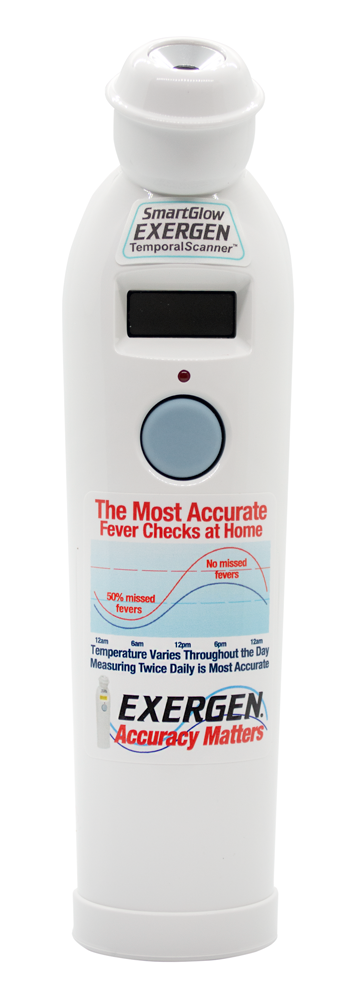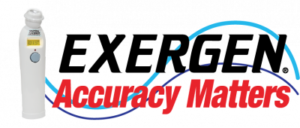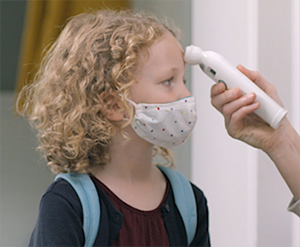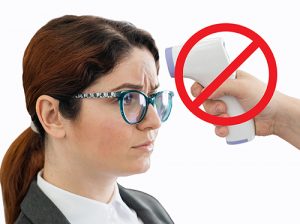Trade Up for Accuracy
ACCURACY MATTERS, especially when deadly diseases are a threat to your health and your family’s health, and Covid is a deadly disease.


Non-contact thermometers are not accurate and are proven to miss fevers at an alarming rate, creating potential danger if they are relied upon for identifying fevers. Accuracy of Exergen TemporalScanner Temporal Artery Thermometers is proven by more than 100 peer-reviewed published studies, and are relied upon by millions of physicians and nurses for their patients, and for their families. Scientific details follow below.
Trade-up rebate for any non-contact thermometer when you purchase an Exergen TAT-2000C Model.
 Q&A's on Thermometer Accuracy
Q&A's on Thermometer Accuracy
Q: What makes thermometers accurate? What should we know about thermometer accuracy?
A: Published peer-reviewed clinical studies.
Without such studies by medical professionals, there is no assurance of accuracy on children and adults in all settings. Accuracy specifications by manufacturers of thermometers are laboratory accuracy, not accuracy in actual use on people being tested for fever. Laboratory accuracy tests do not include important physiological effects which vary from person to person, and setting to setting, which can affect the actual accuracy well beyond their laboratory accuracy.
Published peer-reviewed clinical studies are the gold standard for accuracy, since they include actual use on people in many settings, which automatically includes the physiological effects that vary from person to person and setting to setting. Only these studies can provide the assurance that the thermometer will provide accuracy in detecting fevers for all ages in all settings.
With more than 100 published peer-reviewed clinical studies attesting to the accuracy on all ages from newborns to geriatrics, in all settings where fever detection is needed, the Exergen Temporal Artery Thermometer is by far the most proven accurate, compared to thermometers which have no or very few clinical studies.
Q: Have non-contact thermometers been compared to Exergen TemporalScanner thermometers?
A: Yes, in a new study published in 2020.
New Data Confirms No-Touch Thermometers Miss 5 Out of 6 Fevers
First Study Comparing Accuracy of No-Touch Devices to Temporal Artery Thermometers has Serious Implications; Thermometer “Guns” Can Create False Sense of Security in Mass COVID-19 Screenings and at Home.
As COVID-19 continues to set new records nationwide, the importance of understanding the difference in accuracy between temporal artery thermometers (TAT) and non-contact devices – now used widely for public temperature screenings – is of paramount importance. Non-contact thermometers are proven to be ineffective in measuring actual body temperature, while the accuracy of the TemporalScanner is supported by more than 80 peer-reviewed published clinical studies. This has serious ramifications for family health and public safety.
A new study in the American Journal of Infection Control is the first to compare the accuracy of no-touch thermometers to temporal artery thermometers. Australian researchers conducted a prospective observational study on a sample of 265 non-infectious patients at two hospitals. When body temperatures read below 99.5 degrees Fahrenheit, the thermometers showed similar results, but as temperatures rose above that, non-contact scanners’ accuracy decreased. Temperatures were farther apart as they rose. The non-contact scanners missed five out of every six fevers detected by Exergen temporal artery thermometers.
According to the authors, “This is the first study to compare the accuracy of non-contact infrared thermometers (NCIT) to TAT in adult patients. Although mass fever screening is currently underway using NCIT, these results indicate that the NCIT may not be the most accurate device for fever mass screening during a pandemic.”
A new study on 538 patients in a military hospital found even worse results for the non-contact thermometers, missing 9 out of every 10 fevers detected by a reference contact thermometer.
“During this escalating and unpredictable pandemic, there is one constant in helping to ensure public safety: the ability to accurately screen for fever,” said Francesco Pompei, Ph.D., CEO of Exergen Corporation. “Non-contact thermometers are proven to be inaccurate in measuring core body temperature, yet they’ve been used extensively from the start of the pandemic, giving a false sense of security. In public settings, they are largely ‘theater,” and as such their use should be seriously questioned. Only thermometers with extensive clinical studies, such as the Exergen TemporalScanner, can be trusted for accuracy during these threatening times of COVID.”
Read more about comparing the accuracy of no touch thermometers vs temporal artery thermometers.
Q: Do asymptomatic people transmit the Covid-19 virus? If they do not, does this make thermometer accuracy irrelevant for fever screening to prevent transmission of the virus?
A: Previously, the general understanding in medicine was that asymptomatic individuals testing positive for the Covid virus were likely to transmit the virus to others. A recently published study in a JAMA (Journal of the American Medical Association) publication proved that Covid positive symptomatic individuals were transmitting the disease 26 times more frequently than asymptomatic Covid positive individuals. This means non-contact thermometer inaccuracies were believed to be unimportant since detecting fever was unimportant in detecting a Covid positive individual who was likely to transmit the disease. Now that the importance of symptoms, primarily fever, for disease transmission has been clearly identified, thermometer accuracy is critical in preventing disease transmission.
New Data Confirms No-Touch Thermometers Miss 5 Out of 6 Fevers
First Study Comparing Accuracy of No-Touch Devices to Temporal Artery Thermometers has Serious Implications; Thermometer “Guns” Can Create False Sense of Security in Mass COVID-19 Screenings and at Home.
JAMA Network has published a meta-analysis of 54 studies, encompassing 77,758 participants, that shows symptomatic people who test positive are 26 times more likely to transmit the virus than asymptomatic people who tested positive for the virus in a household setting. The data indicated that 18% of COVID patients who had symptoms spread the virus in the household, while only 0.7% of those without symptoms transmitted it.
With fever being the leading symptom of coronavirus, the need for accurate temperature screening becomes an even greater imperative. This can only be accomplished by using a personal thermometer like the Exergen TemporalScanner, whose accuracy has been proven in more than 100 peer-reviewed, published clinical studies. Studies demonstrate non-contact thermometers are inaccurate1, missing as many as 9 out of 10 fevers. They could provide a false sense of security and negatively impact how families manage the spread of coronavirus in a household.
“Fever is the leading symptom of COVID-19, and these new studies reinforce the importance of accuracy in temperature taking. Accuracy matters, because knowing whether or not you have symptoms helps you manage the transfer of the virus in a household,” said Francesco Pompei, Ph.D., CEO of Exergen Corporation. “You can’t afford to take a chance with anything other than a thermometer whose accuracy has been proven in clinical studies.”
 Q: Can the Exergen TemporalScanner Thermometer be used for screening multiple people?
Q: Can the Exergen TemporalScanner Thermometer be used for screening multiple people?
A: Yes. The non-contact thermometers have been popular for this type of screening due to the non-contact aspect of the devices. However, the first priority is to detect fevers to prevent symptomatic people from passing the disease to others. Unfortunately, the non-contact devices fail to do this due to inherent inaccuracies, causing transmission of the virus instead of keeping the person from entering the premises.
With the Exergen TemporalScanner, the fever detection priority in temperature screening is met due to the proven accuracy. The method used daily by millions of nurses and physicians to prevent cross contamination of patients when using an Exergen TemporalScanner is to simply wipe the head of the thermometer with alcohol between patients, or employ a probe cap that can be changed between patients. This process is performed in ten seconds or less.
Q: Improving Accuracy: How do circadian rhythms impact temperatures and assessments of temperatures?
A: Our internal biological clocks produce circadian cycles that vary throughout the 24 hours of each day. This causes body temperature to vary about 1.6°F (0.9°C) between lowest temperatures in the morning and highest temperatures in the evening. With fever, the circadian variation still occurs, but at higher temperatures.
Accordingly, temperature assessments in the morning are low and will miss about half of the fevers. Temperature assessments in the evening are high and will detect all the fevers.
Mornings Not Ideal for Fever Screening. NYTimes/Reuters, May 27, 2020
“Morning fever screenings may be misleading.
As businesses and cities reopen, screening people for fever when they arrive in the morning at work or school is likely to be widely used to help prevent coronavirus spread. But “morning may be the worst time” to screen for fevers, researchers say. They draw this conclusion from data collected from more than 300,000 people during studies of flu outbreaks in earlier years. “Fever-range temperatures… were rarest during mornings, and were about half as common during mornings as during evenings in periods of high influenza activity,” they report in a paper published on Tuesday without peer review on the medRxiv preprint server. “The results suggest that morning temperature measurements could miss many febrile disease cases,” they said.” (Read the Article)
Recent Published Studies on Circadian Effects on Fever
Harding et al (2020). Fevers Are Rarest in the Morning: Could We Be Missing Infectious Disease Cases by Screening for Fever Then? Undergoing peer review at https://doi.org/10.1101/2020.05.23.20093484
Harding et al (2020). Fever incidence Is Much Lower in the Morning than the Evening: Boston and US National Triage Data. West J Emerg Med. 2020 Jun 24;21(4):909-917. doi: 10.5811/westjem.2020.3.45215. https://www.ncbi.nlm.nih.gov/pmc/articles/PMC7390559/
Harding et al (2019). The daily, weekly, and seasonal cycles of body temperature analyzed at large scale. Chronobiol Int. 2019 Dec;36(12):1646-1657. doi: 10.1080/07420528.2019.1663863. Epub 2019 Sep 17. https://publishingimages.s3.amazonaws.com/eZineImages/PracticePerfect/706/The_daily_weekly_and_seasonal_cycles_of_body_temperature.pdf
Medical information disclaimer: this document may contain general information relating to various medical conditions and their treatment. Such information is provided for informational purposes only and is not meant to be a substitute for advice provided by a doctor or other qualified health care professional. Readers should not use the information contained herein for diagnosing a health or fitness problem or disease, and should always consult with a doctor or other health care professional for medical advice or information about diagnosis or treatment.

